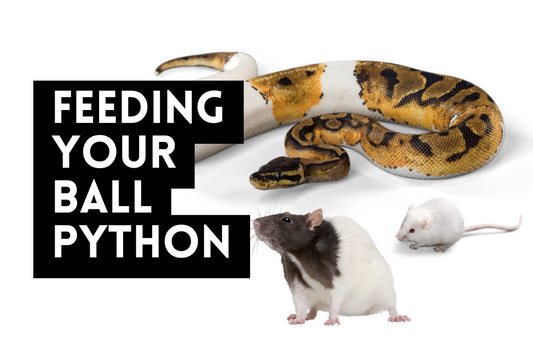Ultimate Ball Python Care Guide: Setup, Feeding & Handling Tips for Beginners
Share
Ball Python Care Guide: Setup, Feeding & Handling Tips
Ball pythons (Python regius) are among the most popular pet snakes—and for good reason. They’re calm, beautiful, relatively easy to care for, and come in hundreds of stunning morphs. Whether you just purchased your first baby ball python or you’re researching before bringing one home, this guide will walk you through every step of responsible ball python care, including enclosure setup, feeding schedules, and proper handling.
Ball Python Enclosure Setup
✔️ Enclosure Size
While pet stores often recommend 20-gallon tanks, adult ball pythons need more room. The minimum recommended enclosure size for an adult is 4'x2'x2'. For hatchlings and juveniles, you can start smaller, but plan to upgrade within the first year.
✔️ Best Enclosure Types
- PVC Reptile Habitats (Best for heating & humidity control)
- Glass Terrariums (Economical, but dry out)
- Enclosures with front-opening doors for easy access.
✔️ Heating & Temperature Gradient
Maintain a thermal gradient:
- Warm side: 88–92°F
- Cool side: 76–80°F
- Ambient: 78–82°F
Use a thermostat-controlled under-tank heater or radiant heat panel.
✔️ Humidity Levels
Maintain 55–65% humidity; increase to 70% during shedding. Always offer fresh water and mist if necessary.
✔️ Substrate
Best Substrates for Ball Pythons:
- Coco husk
- Cypress mulch
- Bioactive (with springtails and isopods)
Avoid:
- Reptile carpet (can harbor bacteria)
- Sand, cedar, or aspen
✔️ Hides & Enrichment
- Provide at least two hides (one on each side)
- Add branches, leaf litter, and clutter for security
- A large water dish helps maintain humidity and offers soaking opportunities
💡 Recommended product: See our recommended enclosures
Ball Python Feeding Guide
✔️ What to Feed
Ball pythons are carnivores and thrive on rodents. Feed frozen/thawed rodents sized to your snake’s widest point:
- Hatchlings: pinkies or fuzzies
- Juveniles: small mice or rat pups
- Adults: small to medium rats
✔️ Feeding Schedule
- Hatchlings: every 5–7 days
- Juveniles: every 7–10 days
- Adults: every 10–14 days
✔️ Frozen/Thawed Feeding Tips
- Thaw completely and warm prey to approximately 105 degree Fahrenheit using warm water.
- Feed in the enclosure, ball pythons rarely have feeding aggression
- Use feeding tongs to avoid accidental bites
- Don't handle your snake for 48 hours after feeding to avoid regurgitation
- Juveniles: every 7–10 days
- Adults: every 10–14 days
✔️ Refusing Food?
Check for:
- Improper temps/humidity
- Upcoming shed
- Stress from relocation
- Seasonal fasting (especially males)
Stay calm—ball pythons are notorious for fasting. Monitor weight and keep records.
🐭 Shop our frozen rodent selection.
Ball Python Handling Tips
✔️ When to Start
Wait 5–7 days after arrival and ensure your python is feeding regularly before handling.
✔️ How to Handle
- Wash your hands before and after
- Approach calmly from the side, not above
- Support the full body, especially the head and midsection
- Avoid gripping tightly—ball pythons will ball up when nervous - it's okay. Stay calm.
✔️ Handling Frequency
3–5 times per week for 10–15 minutes is ideal. Daily handling is okay if your snake tolerates it and isn’t in shed or stressed.Avoid handling while shedding or immediately after meals.
When not To handle your ball python
- Within 48 hours of feeding
- During or right before shedding
- If your snake seems defensive or overly stressed
✔️ Signs of Stress
- Hissing or striking
- Balling up tightly
- Constant hiding
- Refusal to eat
Patience is key. The more calm, consistent handling you provide, the more comfortable your snake will become.
🐍 Need help choosing a beginner-friendly morph? Check out our Top 10 Beginner Morphs.
Ball Python Care Checklist
- 4'x2'x2' Enclosure
- Digital thermometer and hygrometer
- Under-tank heater or radiant heat panel with thermostat
- 2 Hides + Water Bowl
- Feeding tongs
- Frozen/thawed rodents
🐍 Health Tip: Schedule regular weight checks and keep a simple feeding log to track habits.
Conclusion
Ball pythons are beautiful, docile, and rewarding pets. With proper care, they can live 20+ years. Make sure your setup is correct, feed on schedule, and handle gently to build trust and reduce stress.
Ready to bring one home? Browse our available ball pythons now — shipped overnight to the lower 48 states.












